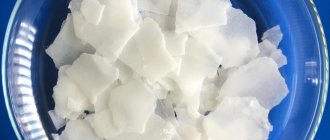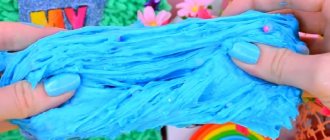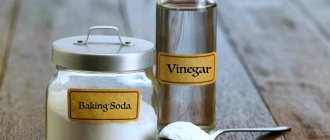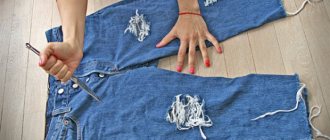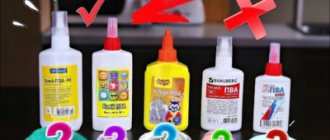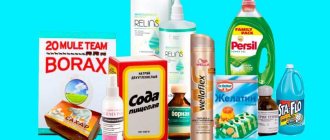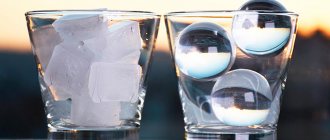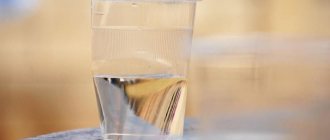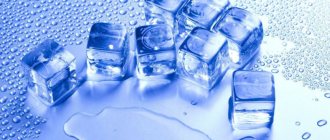What kind of substance is soda ash?
The substance is actively used at home and is available in the form of crystalline powder or granules. Soda ash is extracted from minerals, as well as through special reactions. You may come across several names for this powder: sodium carbonate, technical soda, sodium carbonate or sodium carbonate. They are all the same substance - soda ash.
Properties of soda ash
The formula of the substance is a close bond of 2 sodium molecules, 1 carbon and 3 oxygen. The sodium salt of carbonic acid actively enters into chemical reactions with various substances, which is why it is widely used in production and at home.
Sodium salt is highly soluble in water and interacts with moisture, so keeping it in an open container in highly humid places is not recommended.
In the industrial sphere, the substance is used in soap making, as components of household chemicals and some enamels, and in glass production.
Is soda ash an alkali or an acid?
If you look at the formula of the substance, you will notice that soda ash is a salt that, when interacting with water, forms an alkaline environment. Sodium salt has a fairly high pH of 11, so in most cases it can be used instead of alkali. The substance is not an acid.
Why is soda better than Antiscale?
We are talking not only about the product called “Antinakipin”, but also about all analogues of domestic and imported production. The composition usually includes fairly harmless organic acids (citric, adipic, sulfamic, etc.), but sometimes quite caustic substances, and Chinese analogues can contain anything at all.
Instructions and ingredients not written in Russian or their absence should alert you. If the composition says: “natural organic acids and auxiliary substances” - this means nothing is said! The manufacturer hides the composition of the product from you. Specific active ingredients must be indicated. It is better not to use such suspicious products, but to choose something safer for cleaning, such as soda or vinegar. After all, you drink water from the kettle yourself and feed it to your children.
After such cleaning, stainless steel cookware may suddenly become covered with black spots, which are not a pleasant task to remove. Cleaning electric kettles with Antiscale is also risky. There have been cases when Trilon, which is part of the product, corroded the nickel-plated coating of the heating disk, and the kettles had to be thrown away.
Advice: if you decide to use Anti-Scalp, carefully read the instructions and follow the dosages.
How to use soda ash in the kitchen
Soda ash can replace a number of household chemicals. The substance is useful for cleaning the kitchen and washing dishes.
Dishwashing liquid
You can make a natural dishwashing detergent from sodium salt. To do this, prepare a solution of 0.5 liters of water and 1.5 tbsp. spoons of the substance. As with regular dishwashing detergent, apply the liquid to a sponge and scrub plates, cups and cutlery. After washing, be sure to rinse the dishes with clean water.
You can also use technical soda to wash dishes in the dishwasher. To do this, when fully loaded, add 2 teaspoons of sodium salt and the same amount of borax to the tank, and turn on the washing function. After completing the procedure, the plates will not only be clean, but also disinfected.
Cleaning difficult stains
If, over time, the cutlery has turned yellow, and a slight soot or scale has appeared on the dishes, try preparing a washing solution based on sodium salt with the addition of liquid and laundry soap.
Prepare a large saucepan and fill it halfway with water. Add here 100 g of sodium carbonate powder, the same amount of laundry soap shavings and 100 ml of liquid soap. Place dirty dishes in a container and boil for 20 minutes. Rub the softened dirt with a sponge, then rinse the containers and utensils to be cleaned with clean water.
Carbon remover
Using soda ash, you can remove stubborn carbon deposits on pans and pots.
Please note that it is strictly not recommended to process containers made of aluminum, cast iron or copper.
This method of removing carbon deposits is more suitable for enamel and ceramic containers. For the procedure you will need:
- 1 package of soda ash;
- a bar of laundry soap;
- 2–3 bottles of silicate glue;
- large capacity for boiling.
Procedure:
- Place the container to be cleaned in a large saucepan.
- Fill with water.
- Add a packet of sodium carbonate to the liquid.
- Pour silicate glue into this and add a pod of laundry soap.
- Place the container on the stove and turn on the heat.
- Boil the mixture. Adjust the boiling time yourself depending on the degree of contamination. Typically cleaning takes from 20 minutes to 2 hours.
- Turn off the heat and cool the container being processed.
- At the last stage, rinse all the pots under running water.
Treatment with sodium salt will help get rid of not only carbon deposits, but also other contaminants and deposits.
How to clean tiles
You can use a cleaning composition made from soda ash to wash tiles in any room. To prepare it, add 60 g of the substance to 1 liter of water and mix thoroughly. Apply the product to the tiles and scrub with a metal sponge. After treatment, wash the surfaces with a damp cloth.
Stove cleaning paste
To remove stubborn greasy stains on grates and stovetop or oven surfaces, you can prepare a solution of sodium salt.
Step by step steps:
- Mix 6 tbsp in 2 liters of water. spoons of technical soda, 2 tbsp. spoons of regular washing powder and the same amount of silicate glue.
- Mix the ingredients thoroughly.
- Treat all contaminated surfaces with the mixture.
- Leave the solution to act for 10-12 minutes.
- Remove softened dirt with a damp sponge.
Repeat the procedure if necessary. The finished solution can be stored, but only in tightly closed containers.
Cleaning the kettle from scale
Technical soda does an excellent job of removing scale from inside teapots. To treat the inner surface of a classic or electric kettle, you can prepare 2 solutions using different methods.
Method 1:
- Fill the kettle with water to the maximum level.
- Add powder to the water at the rate of 1 teaspoon of powder per 1 liter of water.
- Boil water in a kettle for 5 minutes.
- Drain off any remaining sediment.
- At the last stage, boil clean water in a kettle.
Method 2:
- Apply a small amount of sodium carbonate to a damp sponge.
- Scrub the interior surfaces thoroughly with the sponge.
- Pour clean water into the kettle and boil.
- Drain the water and rinse the container thoroughly.
Using similar methods, you can process not only teapots, but also any other utensils.
Recommendations for use
In everyday life, calcium carbonate remains one of the most popular substances. This is due not only to its cleansing qualities, but also to the low cost of the product, which, moreover, can be made independently from affordable baking soda.
- To restore the cleanliness of the tiled surface, dissolve 60 g of sodium carbonate crystals in a liter of slightly warmed water. Saturate a hard cup and wipe off all dirt. Residues are removed with a clean damp cloth.
- If necessary, it is easy to independently prepare a composition that washes and degreases dishes well. You need to measure 3 tbsp. l. homemade soda ash. Dilute it with a liter of warm water. Kitchen utensils washed with the product are rinsed well with running water.
- To clean the stove, add 1 tbsp sodium carbonate to 200 ml of warm water. l. Add washing powder and silicate glue - 1 tsp each. Stir until smooth. Distribute over contaminated surfaces. After 15 minutes, wipe with a damp sponge.
Soda ash for cleaning plumbing fixtures
Sodium salt-based cleaners do an excellent job of removing limescale and stains on plumbing fixtures. To treat a toilet, sink or bathtub, you can use several options for a solution of the substance.
Soda-soap mixture
To prepare, you will need 100 g of technical soda and the same amount of laundry soap shavings. Mix the soap and powder thoroughly. Add a little water to the mixture until you get a thick paste. For aroma, you can add a few drops of aromatic oil to the mixture.
Apply the resulting mixture to the plumbing fixtures and leave to act. After 60 minutes, remove the cleaning mixture with a cloth and rinse the surface.
Treatment with vinegar and soda ash
Plumbing treatment is carried out in 2 stages. Initially, treat the bathtub, sink or toilet with table vinegar. After this, sprinkle the surface with soda ash powder. Wait 15 minutes, then scrub the stains with a sponge and rinse the surface with water.
How to clean an old bathtub with a mixture of two types of soda
For such processing you will need not only soda ash, but also baking soda. In addition, prepare some water, vinegar and bleach for the procedure.
Procedure:
- Mix 2 types of soda in equal proportions and dilute a little with water to a paste.
- Apply the substance to the surface of the bathroom.
- Leave to act for 10–15 minutes.
- Meanwhile, combine equal amounts of vinegar and bleach.
- Apply the chlorine-acetic mixture to the surface.
- Leave to act for 30 minutes.
- Rinse off any remaining detergent with clean water.
In a similar way, you can clean not only the bathtub, but also other plumbing fixtures: the toilet or sink.
How to clear clogged pipes
Soda ash solution helps clear blockages in pipes. The substance perfectly corrodes food debris, greasy and old plaque. You can prepare the product in two ways.
Method No. 1 with boiling water
To clean, you will need 125–150 g of the substance and 1 liter of boiling water. Pour baking soda into the drain hole and pour boiling water over it. Wait for 30 minutes and then flush the drain with plenty of water.
Method number 2 with vinegar
For the second cleaning option, in addition to soda ash, you will need 150 ml of vinegar and the same amount of bleach. Pour sodium salt into the drain, then add vinegar and bleach. Close the hole with a stopper and leave for 30 minutes. After this, pour 3 liters of boiling water into the drain. Be careful, chlorine vapors are very dangerous, so cover your mouth with a bandage and open all windows in the room. At the end of the procedure, rinse the drain with running water.
Description of the technological process
The production of soda ash using the ammonia method includes 8 main stages:
- obtaining carbonate raw materials: stripping, blasting, mining, crushing, sorting of raw materials and transportation;
- processing of carbonate raw materials: roasting, cooling and purification of carbon dioxide, slaking of lime to produce a lime suspension;
- brine purification: interaction of raw brine with reagents in reactors and brine sedimentation;
- absorption: washing gases released at other stages from ammonia in washers, two-stage saturation of a sodium chloride solution with ammonia and partially carbon dioxide coming from the distillation stage, cooling of the ammoniated brine;
- carbonization: washing of ammonia from the gas leaving the carbonization stage (accompanied by the capture of carbon dioxide), preliminary carbonization, carbonization with the release of sodium bicarbonate in precipitation columns, compression (before feeding into the carbonization columns) of carbon dioxide coming from the stages of raw material processing and calcination;
- filtration: separation of sodium bicarbonate on filters and air suction using vacuum pumps;
- calcination: dehydration and decomposition of sodium bicarbonate in soda furnaces, cooling and purification of carbon dioxide after soda furnaces;
- ammonia regeneration (distillation): preheating and dissociation of ammonium carbonates and bicarbonates contained in the filter liquid in the condenser and distillation heat exchanger, mixing and interaction of the heated liquid with a lime suspension in the mixer and distillation of ammonia in the distiller.
The entire soda process can be completely represented by the following chemical equations: NH3+H2O= NH4OH CO2+ H2O=H2CO3 H2CO3+ NH4OH= NH4HCO3+ H2O NH4HCO3+ NaCl=NaHCO3+ NH4Cl 2 NaHCO3→Na2CO3+ H2O+ CO2 CaCO3 → CaO+ CO2 CaO+ H2O= Ca(OH)2 Ca( OH)2+2 NH4Cl= NH4OH+CaCl2 NH3 H2O The mutual relationship of reactions can be represented by the following scheme: CaCO3=CaO+CO2 NaCl + NH3 + CO2 + H2O↔ NH4Cl+ NaHCO3 CaO+ H2O→ Ca(OH)2 –ΔΗ=63.8 kJ /mol Ca(OH)2 +2 NH4Cl→2 NH3 + CaCl2 + H2O+ΔΗ=27.6 NaHCO3→Na2CO3+ CO2+ H2O+ΔΗ The implementation of the chemical model involves the development of a technological regime using the physicochemical properties of an aqueous four-component system. In an aqueous solution there are 4 components NaCl - NH4HCO3 - NH4Cl - NaHCO3 (there are four independent components, because if the values of three components are known, then the content of the fourth can be calculated using the reaction equation.) The salt NH4HCO3 is formed as a result of the interaction of CO2 and NH3 in a solution: CO2 ( p) + 2NH3(p)↔NH2COONH4(p) – ΔΗ1 The resulting carbamate is hydrolyzed: NH2COONH4(p) + H2O ↔ NH4HCO3(p) + NH3(p) + ΔΗ2 — ΔΗ + ΔΗ= -63.8 kJ Temperature regime selected by the results of the reaction study, and material calculations and ratios of the reacting components were determined based on data on the four-pole system. Below are graphical methods for developing a process regime for reactions of this type. Based on the diagram (Fig. 1), it is established that sodium chloride interacts with ammonium bicarbonate, forming sodium bicarbonate and ammonium chloride, and the solubility of sodium bicarbonate in this system is low, since in an equilibrium solution 1 mole of bicarbonate dissolves in 4240 moles of water, i.e. e. practically falls into the solid phase. System Na+, NH+4║Cl-, HCO3- - H2O, T 30ºС: А-NaС1; B-NaHCO3; C-NH4HCO3; D—NH4C1; i-amount of H2O - moles of water/1 mol of Σ salts; i* - equilibrium, inp - practical R-ratio A : C entering the reaction; Р – salt composition of the solution Projection of the system Na+, NH4+║Cl-, HCO-3- H2O, Т 30ºС: А-NaС1; B-NaHCO3; C-NH4HCO3; D—NH4C1; e – salt composition of eutonic solutions of two-component systems; P – invariant points of a four-component system; R is the salt composition of the reaction mixture. The stable diagonal of the salt square, which intersects only two crystallization poles, is the diagonal of sodium bicarbonate - ammonium chloride, the ratio between the reacting components is selected graphically according to the projection of the diagram, taking into account the need to obtain sodium bicarbonate that does not contain ammonium salts in the solid phase. This technique is illustrated in Fig. 3. It consists in creating a slightly increased water content in the solution compared to the invariant figurative point P1, to which the crystallization beam is directed. Cross-section of the diagram according to ARP1: i*LBN – amount of water in the equilibrium solution; iR.pr – amount of water in the process solution; ip1 is the amount of water in solution P1; R – figurative point of the reaction mixture. The essence of the process can be expressed in such a way that when treating a brine saturated with ammonia with carbon dioxide, first there is a sort of neutralization of this solution with carbon dioxide, accompanied by a significant release of heat, and then, as the concentration of the average ammonium carbonate salt in the solution increases, its exchange decomposition with table salt to form soda, which, upon further action on the carbon dioxide solution, forms the least soluble compound - bicarbonate. From a practical point of view, it is interesting not only the course of the reaction and the achievement of the best yield of bicarbonate, but also the quality (physical properties, structure) of the resulting bicarbonate precipitate. Under factory conditions, when the precipitation of bicarbonate begins at a slightly elevated temperature, and the growth of crystals occurs upon cooling, the result is a coarse, crystalline, well-settled, well-filtered and well-washed precipitate. The cooling limit in factories is most often a temperature of 28 – 30ºС, but sometimes lower – up to 25ºС. The structure of the sediment is of great importance, since the ease and speed of filtration and washing reduces the consumption of steam for the distillation of mother liquors, and, in addition, reduces the moisture remaining in the bicarbonate after filtration, which in turn facilitates the calcination of the sediment and reduces fuel consumption for this process. Too much cooling causes the formation of very fine, silt-like sediment, which is difficult to filter and disrupts and increases the cost of normal production. Purification of table salt brine At soda factories, raw brine is purified from impurities using the lime-soda method. In this case, soda is used to precipitate calcium salts, and a lime suspension is used to precipitate magnesium salts. The lime-soda method is based on ion exchange reactions leading to the formation of sparingly soluble calcium carbonate and magnesium hydroxide: Ca2++CO32-↔CaCO3; Mg2++2OH-↔Mg(OH)2 The completeness of the release of magnesium and calcium ions into the sediment, and therefore the degree of purification, is determined by the solubility of CaCO3 and Mg(OH)2 in a sodium chloride solution. An indirect parameter characterizing the completeness of the release of Ca2+ and Mg2+ into the sediment can be the pH value, which is important when creating an automatic control system for the purification process. The main difficulties of the first stage of brine purification are the low rate of thickening of the magnesium hydroxide suspension and the unsatisfactory rate of filtration of the thickened suspension. It has been established that during the precipitation process, the formation of an amorphous (or close to amorphous) product with a fairly high solubility occurs. The duration of its existence depends on the composition of the mother liquor, temperature and properties of the alkali used. This product is hydrated magnesium hydroxide: Mg(OH)2·(H2O)m. The distance between the cleavage planes of such a hydroxide is greater than the length of the water molecules. The process of sediment ripening, which can last several days, can be described by the equation Mg(OH)2·(H2O)m→ Mg(OH)2+mH2O; 1
Methods for using soda ash to wash clothes
One of the main properties of the substance is the purification of natural materials from contaminants. You can use soda ash for soaking, boiling, hand washing or automatic washing. Please note that only natural materials made from cotton and linen can be treated with a solution of technical soda.
Soak
The soaking procedure is more suitable for white materials, since colored items may lose color saturation.
Rules for soaking products in a sodium carbonate solution:
- Dissolve 75 g of powder in 5 liters of water.
- Place the product in a container with the solution and leave overnight.
- If there are persistent stains on your clothes, wash the stains with laundry soap before the procedure.
- After treatment, wash your clothes as usual.
To soak colored items, so as not to spoil the color fastness, prepare a less saturated solution by dissolving 1.5 tbsp in 5 liters of water. spoons of powder. Processing instructions remain unchanged.
Handwash
You can use soda ash both instead of washing powder and to soften water and strengthen detergent.
Before the procedure, be sure to wear gloves on your hands to prevent skin burns. If the solution gets on your hands, rinse the skin with plenty of water, dry it and lubricate it with a rich cream.
Machine washable
When used in automatic washing, soda ash will not only improve the quality of the powder, but will also remove scale and limescale deposits in the washing machine.
Add 75 g of soda to the washing machine compartment along with the powder and run a standard wash.
Fight stubborn stains
If you have stubborn grease or gasoline stains on your clothes, use a little more soda ash powder than you would with normal washing. For example, to wash heavily soiled items in automatic washing, add 5 tbsp to regular powder. spoons of sodium carbonate.
Boiling laundry
Boiling with technical soda will help improve the bleaching effect. The procedure will not only remove contamination, but also disinfect the material.
Mode of application:
- For boiling, choose a container made of metals that do not react with the substance. It is strictly not recommended to use aluminum and copper pans.
- Before the procedure, provide access to fresh air in the room, and during the procedure, try not to inhale fumes.
- Dissolve 500 g of soda ash powder and 500 ml of white in 10 liters of water.
- Place the laundry in a pan and boil for 40–60 minutes.
After the procedure, wash your items as usual.
Washing gel
You can make an effective hand washing gel from soda ash. In addition to sodium carbonate, you will need:
- 2 tbsp. spoons of glycerin;
- 100 g laundry soap;
- a few drops of essential oil.
Cooking method:
- Boil 2 liters of water.
- Add laundry soap to the liquid.
- Boil the mixture until the soap is completely dissolved.
- Add 150 g of sodium salt.
- Boil the solution for 3 minutes.
- Remove the container from the heat and add glycerin.
- At the last stage, pour essential oil into the mixture and mix thoroughly.
When the mixture has cooled completely, pour it into a beautiful bottle and use it instead of hand wash gel.
Soda ash for washing baby clothes
You can also use a gel made from soda ash to wash children's clothes. The main condition is that the product is made of cotton or linen. You can also soak baby clothes in a solution and sodium salt by dissolving 50–75 g of powder in 5 liters of water.
Sodium carbonate in everyday life
Although baking soda is often used as a cleaning agent, only sodium carbonate can cope with very heavy stains.
Surface cleaning
Knowing the secrets of using soda ash, you can significantly reduce financial costs, because the need to purchase expensive cleaning products will simply disappear or be reduced to a minimum.
Bathroom
The substance copes well with various contaminants: soap deposits, limescale, sebum, rust, urinary stones. To clean the surfaces of your bathtub, shower and/or toilet, you will need:
- 3 tablespoons baking soda,
- 3 tablespoons soda ash,
- 1/3 cup liquid bleach
- 1/3 cup 9% table vinegar,
- spray,
- sponge.
Application
- Mix both types of soda in a small container that you do not use for cooking.
- Rinse surfaces that need cleaning with cold water.
- Using a damp sponge, apply the previously prepared mixture to the surface of the bathtub, sink or toilet and leave for 30 minutes,
- Mix bleach and vinegar in a spray bottle.
- Spray the liquid on the surface over the baking soda,
- After the reaction of the substances has completed, which is manifested by the appearance of foam and hissing, rinse off the remaining cleaning product from the surface using a watering can or shower head.
If there are small stains on the surfaces, you can lightly rub them with the hard side of the sponge, and then rinse everything with water again.
Tile
Soda ash is mixed with water in a proportion of 2-3 tablespoons of the substance per 1 liter of liquid, applied with a sponge to the surface and left for 5-10 minutes. The cleaned tiles are wiped several times with a clean damp cloth.
I live in an area with high humidity, so I constantly have to deal with mold. A particular problem was the blackening gaps between the tiles in the bathroom and kitchen. Having tried many remedies, I came to the conclusion that soda ash fights this problem most effectively. To get the walls in order, I apply sodium carbonate to the areas affected by mold, after wetting them with warm water. Then I rub in the powder with a medium-coarse brush and leave for 15–20 minutes. After this, it is enough to remove the remaining substance with a clean sponge and wipe everything dry.
Floors
In a bucket of hot water you need to dilute 3 tablespoons of soda ash. After wiping the floors with the resulting solution, be sure to carry out another washing step, this time with clean water. This measure is necessary in order to remove any remaining active substance. This product is only suitable for washing natural stone, tile or linoleum surfaces. Under no circumstances should sodium carbonate be applied to natural or painted wood floors, laminate, or parquet.
Gas oven and stove
One of the ingredients for making a cleaning product for your kitchen helpers is silicate glue (liquid glass), which can be purchased at office supply stores or hardware stores.
Ingredients:
- 3 tablespoons soda ash,
- 1 tablespoon silicate glue,
- 1/2 tablespoon of washing powder,
- 250 ml water.
Manufacturing and application:
- Place all ingredients in a suitable sized container and mix thoroughly,
- Apply the resulting mixture to dirty surfaces of the stove and oven, as well as to the grates. Leave it like this for 15–30 minutes,
- When the grease on the surfaces has softened, remove it using a sponge.
- Wipe the surfaces with a clean, damp cloth several times to remove any remaining baking soda.
If the surfaces of the stove and oven are heavily soiled and it was not possible to clean them completely the first time, you should repeat the manipulations.
Removing old paint
As a kind of softener for old paint, a mixture of lime mortar and sodium carbonate, prepared in a 3:1 ratio, is used. The product is applied to the painted surface and left for 15–20 minutes. After about a quarter of an hour, the paint begins to clump, “curd,” and can be easily removed with a spatula or spatula.
Washing clothes
Many phosphate-free washing powders from modern manufacturers contain soda ash. Knowing this, you can increase the activity of the product at home. Sodium carbonate is indispensable in the fight against such difficult-to-remove contaminants as machine oil, fuel oil, gasoline, food fat, sauces and others.
Soaking and bleaching
This method is used for washing heavily soiled white laundry. The clothes are moistened, rubbed with laundry soap and soaked overnight in a solution of soda ash (3 tablespoons per 1 bucket of water). If in the morning the laundry still has slight dirt and a grayish tint, wash it in a machine, selecting the necessary program. If you need to tidy up colored laundry, you should not add more than 3 tablespoons of soda per 10 liters of water, and wash clothes at temperatures above 40 degrees. In addition, colored laundry is soaked for only 2–4 hours.
Handwash
To enhance the effect of the powder when washing by hand, add 3 tablespoons of laundry soda to every 10 liters of water.
Machine washable
Just as in the case of hand washing, sodium carbonate acts as an auxiliary substance in cleaning clothes from various types of contaminants. The amount of soda depends on the hardness of the water in your region and can range from 3 to 5 tablespoons. The substance is poured directly into the drum of the machine. Clothes should be washed at temperatures ranging from 50 to 100 degrees. The higher the temperature, the more active soda ash is.
It is important! Under no circumstances should you wash clothes made of silk, wool, leatherette, rubberized fabrics, materials with a membrane surface and various impregnations with sodium carbonate, as such things become fragile and quickly deteriorate.
Boiling
This method is rarely used, it is suitable for the most severe cases of clothing contamination, as well as for sterilizing it. The most popular options for digestion with the addition of soda are:
- For every 10 liters of water add 0.5 kg of laundry soda and 0.5 liters of liquid chlorine bleach. Boiling time - no more than 1 hour. This composition is very effective, but it is not recommended to boil it often, since after just a few procedures small holes may appear on the fabric,
- For every 10 liters of water - 250 g of soap shavings and 250 g of sodium carbonate. Boiling time can be up to 2 hours. Suitable for boiling clothes of children and people with allergies,
- For every 10 liters of water - 250 g of soap shavings, 250 g of soda, 2 tablespoons of ammonia and 2 tablespoons of hydrogen peroxide. Boiling time - no more than 40 minutes.
Clothes are boiled in a washing machine at maximum temperature or in the “old-fashioned” way using a large container and wooden tongs. Under no circumstances should you use copper or aluminum basins or containers with an enamel coating that is chipped. The ideal option is a galvanized boiler or an enameled bucket with an intact inner surface. To achieve greater efficiency, it is recommended to pre-rub the laundry with laundry soap. This method is not used for colored clothing and delicate fabrics.
How to prepare washing gel
It should be noted that using soda ash at home you can prepare excellent washing gels. Creating such detergents with your own hands does not take much time and effort, and also pleases with the lower cost and washing results, in contrast to purchased powders.
With borax powder
The gel, the description of which you will see below, is suitable for both hand and machine wash. It can also be used topically on specific areas of clothing to remove stains.
Ingredients:
- 150 g of laundry soap shavings 72%,
- 150 g soda ash,
- 150 g borax (sodium tetraborate),
- 2.5 liters of water.
Preparation:
- Pour 0.5 liters of water into the pan and add soap shavings,
- Stirring, heat the liquid until the soap is completely dissolved.
- Pour baking soda and borax powder into a container with water and soap.
- Pour the remaining 2 liters of water into the resulting mixture and mix all the ingredients thoroughly so that not even the smallest lumps remain,
- Allow the liquid to cool, then pour into suitable small containers and close with lids. Within 24 hours the mixture will turn into a gel.
With laundry soap and green tea
This detergent option does not cause allergic reactions and takes care of your skin when washing by hand.
Ingredients:
- 2 liters of water,
- 200–250 g laundry soap,
- 150 g of laundry soda,
- 200 ml green tea.
Preparation:
- Pour the water into a suitable sized container and bring to a boil.
- Pour pre-grated laundry soap into the pan, stir the mixture and heat until. until the chips are completely dissolved in the liquid,
- Add soda ash, mix all ingredients again and boil for 3 minutes,
- Pour green tea into the mixture, stir the product again,
- Cool the liquid and pour into small jars.
Laundry soap can be replaced with any baby, antibacterial or tar soap. To give the gel a pleasant aroma, it is recommended to add a few drops of your favorite essential oil to the cooled mixture.
Video: washing gel from baby soap
Vegetable garden and garden
The use of soda ash is not limited to cleaning surfaces and washing clothes. Experienced gardeners know that using sodium carbonate you can get rid of pests (slugs, ants, caterpillars), destroy powdery mildew, and also get rid of weeds (in this case, soda acts as a herbicide). Plants are sprayed with an aqueous solution of soda or pollinated with dry powder. Auxiliary ingredients may include: laundry soap, wood ash, wheat flour.
My father uses baking soda to remove weeds from between the tiles in the yard. As soon as unwanted plants make their way onto strips of soil, you just need to wet them (water them with water from a small watering can or plastic bottle) and sprinkle them with baking soda powder. After just 1–1.5 days, the grass turns yellow, and after a few days all that remains is to walk along the paths with a hard broom and collect garbage. Of course, this does not eliminate the problem 100% and the procedure must be repeated several times during the warm season. However, worries become significantly less.
Water softeners
To soften water for hand washing or ironing, 2-3 tablespoons of laundry soda are thoroughly mixed in 10 liters of water. After a few minutes, a white precipitate appears at the bottom of the container. Clean water is carefully poured into another container, and the remaining water with undissolved substances is poured into the sink. This water cannot be used for cooking or bathing. To get a drinkable version, repeat the same steps, but replace the soda ash with baking soda. Sodium carbonate can be an excellent substitute for CALGON, a widely advertised anti-scale agent. Just 3-5 tablespoons of soda, added directly to the drum with clothes, will prevent the formation of scale in the washing machine, and will also disinfect it, clean the internal surface of plaque and remove unpleasant odors.
Pipe cleaning
If a pipe is clogged in the house, and there is a treasured box of soda ash in the department with household chemicals, there is no need to run to the store for a special product. What should be done? Pour 3 liters of water into a saucepan and bring to a boil, then add 1/2 the sodium carbonate. Pour the resulting solution into the hole in the clogged pipe, wait 30–40 minutes, then turn on running water and leave the tap open for 4–5 minutes. The soda will dissolve the organic plug, and the water will wash away the remaining substances.
From my own experience I can say that there are cases when this procedure must be carried out twice. However, the fact remains that this method of clearing clogged pipes works successfully.
Disinfection
In addition, soda ash is used to disinfect premises in enterprises where there is a risk of infection with dangerous infectious diseases (hospitals and veterinary clinics, catering and agricultural enterprises, tanneries, cheese factories). Warehouses, store counters, tools and workers' clothing are also treated with sodium carbonate solution.
Removing scale and limescale
If scale and limescale have appeared on pots or other containers, a product based on sodium salt will help. You can clean the container in two ways
Method No. 1
Fill the container 2/3 full with water. Add 75 g of soda to the liquid. Place on fire and boil for 20 minutes. After this, turn off the heat and leave the solution to act. After an hour, scrub the inner surfaces with a metal sponge and rinse the container thoroughly.
Method No. 2
For the procedure you will need soda ash and citric acid.
Procedure:
- Fill the container with water.
- Add the required equal amount of sodium salt and citric acid at the rate of 1 teaspoon per 0.5 liter of water.
- Place the pan on the fire and boil the water.
- Let the solution boil for 15 minutes.
- Turn off the heat and leave the container with the cleaning mixture for 1 hour.
- Turn on the stove again and repeat the procedure.
- Cool the container again and drain the liquid.
- If necessary, scrub heavily soiled areas with a metal sponge.
- Fill the container with clean water and boil a little again.
- At the last stage, drain the water and rinse the container under the tap.
Video: life hacks with baking soda for the home
Bicarbonate solution is a godsend for those who like to take care of themselves, monitor the health and cleanliness of their home and garden, and at the same time understand that they don’t have to spend a lot of money on pharmaceuticals, cosmetics and detergents. However, when taking it orally, it is worth remembering the warnings of doctors: although soda is a fairly harmless folk “medicine”, its abuse leads to alkalosis, that is, alkalization of the body. It causes problems with the heart, respiratory and digestive systems. Everything is good in moderation, as popular wisdom says. Let's follow it!
- home
- beauty and health
- Treatment
Article rating: Loading...Share with friends:TweetSharePlusShareShareSendClassLinkPin Preparing and using a two percent soda solution Link to main publication
Sources
- https://TopSoda.ru/o-sode/vidy/kaltsinirovannaya-tehnicheskaya-soda
- https://clubsamodelok.ru/kalcinirovannaya-soda/
- https://sodaved.ru/byt/kalcinirovannaya-soda-v-bytu.html
- https://navseruki.guru/sovety-po-hozyajstvu/soda-kaltsinirovannaya-primenenie.html
- https://severdv.ru/sovety/sposoby-primeneniya-kalczinirovannoj-sody/
- https://sodalab.ru/sostav-i-svojstva/kak-prigotovit-sodovyj-rastvor.html
- https://TopSoda.ru/beauty-and-health/lechenie/dvuhprotsentnyj-rastvor-sody
Mopping floors
You can use soda ash to clean floors. Pre-prepare a sodium carbonate-based product and then add a small amount to the water for treating floors.
To prepare the product you will need 25–50 g of soda ash and the same amount of liquid soap. Dilute the ingredients in 3 liters of water and pour into a beautiful container. Add the substance to the water when treating floors. For severe stains, apply detergent directly to the stains, leave for 10-15 minutes and wipe with a cloth. After treating with sodium carbonate, be sure to wipe the surfaces with a clean, damp cloth.
Please note that if the floors are made of wood, parquet or laminate, the use of soda ash is not recommended. The same applies to coatings painted with enamel or varnish.
General concepts
Sodium carbonate in varying concentrations has both neutral and increased alkaline activity. Unlike baking soda, soda ash is more aggressive, it does not have a neutral alkaline reaction, it is unsuitable for consumption, irritates the skin, and in certain conditions can cause a chemical burn.
Caustic sodium or caustic is the strongest alkali, easily corrodes any organic matter. You need to be careful when handling it to avoid getting a chemical burn.
Disinfection
Soda ash not only helps with cleaning, but can also disinfect surfaces. To prepare a disinfectant composition, you will need a bucket of water, 200 g of sodium salt and the same amount of laundry soap. Dissolve the substances in water and thoroughly treat all surfaces. Use the soap solution daily immediately after preparation. To wash tiles, replace laundry soap with 50 g of washing powder.
Application in medicine
Soda solution is a real savior from many diseases. Some doctors even insist that sodium bicarbonate can cure cancer.
Gargling with a baking soda solution very quickly and significantly relieves discomfort in the throat.
However, while research on the effect of soda on cancer pathology is still ongoing, we can say with confidence that this substance can cope with many ailments:
- heartburn – the product neutralizes increased acidity;
- colds – sodium bicarbonate can relieve the first symptoms of a cold and prevent the development of the disease;
- diaper rash in infants - the solution promotes rapid healing of wounds on the surface of the skin;
- cystitis - dissolved soda helps the body fight pathogenic microorganisms;
- burns - a solution of sodium bicarbonate applied to the affected area relieves pain, and wounds heal faster;
- hypertension - sodium bicarbonate helps remove excess water and significantly lower blood pressure;
- runny nose - a simple solution of soda and salt perfectly replaces expensive pharmaceutical drugs, and you can rinse your nose with it as much as you like without harm to health;
- thrush - with the help of sodium bicarbonate you can get rid of thrush, which is hated by women, since the Candida fungus is afraid of an alkaline environment;
- lingering cough - with the help of soda and honey dissolved in milk, you can get rid of a long-term dry cough and promote the removal of sputum;
- sore throat - gargling with a soda solution softens the manifestations of the disease, promotes the drainage of purulent plugs and clears the throat, and when the pus drains, the body temperature drops significantly and the person becomes much better;
- dermatitis and psoriasis - soda lotions have an extremely beneficial effect on the affected skin surface;
- calluses, boils and corns, on the surface of which a cotton wool soaked in the prepared product is applied;
- smoking - smokers rinse their mouths with a solution of sodium bicarbonate;
- waste and toxins, which soda dissolved in water successfully removes from the body;
- manifestations of motion sickness in transport.
Cleaning household appliances
With the help of technical soda, you can easily clean household appliances in the kitchen. The solution of the substance does a good job of cleaning the refrigerator, microwave oven, hood and other work surfaces.
To prepare the cleaning solution you will need 6 tbsp. spoons of sodium carbonate and 2 liters of water. Thoroughly dilute the powder in liquid and pour into a container with a spray bottle.
Mode of application:
- Spray the solution onto the surface to be cleaned.
- Leave the product to act for 5-7 minutes.
- Rinse off any remaining substance with clean water.
- Wipe the surface dry.
To clean the microwave oven from grease and dirt, place a container with the solution inside the oven and turn on the heat for 5 minutes. The fatty deposits will soften and you can easily wipe them off with a napkin.
What's good about soda?
Sodium bicarbonate (baking soda) is a white crystalline powder, a weak alkali, used in cooking and baking. As a universal product, it is widely used in everyday life; it can easily clean the oven from grease, bleach laundry, and clean the bathtub. The main advantage of the product is its safety. It’s not scary if a box of baking soda falls into the hands of a small child. During boiling, it does not emit caustic fumes and completely decomposes at a temperature of 60 degrees.
Sodium bicarbonate loosens limescale, disinfects surfaces and removes odors; using a saucer of soda can get rid of the unpleasant smell in the refrigerator, don’t you believe it? But in vain.
It is used to clean enamel, steel, glass, ceramic and electric kettles. It is impossible to ruin dishes with soda. The good news is that after cleaning, no substances harmful to human health remain on the walls of the dishes.
How to remove old paint using soda ash?
Soda ash actively interacts with paint molecules, corroding their structure. This property allows the substance to be used as a paint solvent.
Before you start the procedure, be sure to take safety precautions. When heated, the lime used for the recipe releases chlorine-containing vapors that are dangerous to humans. Put a respirator and safety glasses on your face, and put rubber gloves on your hands.
Procedure:
- Pour 5 liters of water into a large container prepared in advance so that it does not occupy more than 1/3 of the volume.
- Add 1 kg of soda ash to the liquid.
- Heat the mixture to 60 degrees.
- Mix lime with water and add little by little to the solution.
- Apply the finished mixture to the surface to be cleaned with a brush.
- When the paint has softened a little, scrape it off with a spatula.
After treatment, wash off any remaining paint with solvent or water.
Antiseptic properties
Soda destroys pathogens, mold, bacteria and microscopic algae; if you use it for washing in an automatic machine, then fungus will not grow in it and there will be no musty smell.
If mold appeared earlier, then you need to wash all accessible parts of the machine with washing gel based on laundry soda, the recipe for which can be read above, do not forget to bend the rubber seal on the door and wash it well under it, and also run the machine idle at maximum temperature with a glass the same gel. Borax combined with soda ash is very effective against mold. This product is also useful for removing mold from tiles.
Here you can read about how to get rid of mold on the walls without tearing off the wallpaper.
Soda ash is used for disinfection in enterprises where there is a high risk of workers becoming infected with infectious diseases, for example in hospitals, catering establishments, the leather industry, veterinary medicine and agriculture. Hot solutions of sodium carbonate are used to treat surfaces, disinfect counters, warehouses, cheese factories, and boil tools and special clothing. The hotter the water, the greater the bactericidal properties of the solution.
- An 80 degree 2-3% soda ash solution kills the foot and mouth disease virus within an hour. It deals with streptococci in 10 minutes, and with E. coli in 5 minutes.
When working with hot solutions, it is very important to follow all safety measures, wear rubber gloves and safety glasses.
What materials cannot withstand the effects of soda ash?
Despite the widespread use of soda ash in everyday life, it is still not recommended for cleaning certain materials. These include:
- aluminum;
- cast iron;
- copper;
- tree;
- fiberglass;
- brick;
- laminate and parquet;
- paints;
- enamels;
- varnishes;
- wool;
- click;
- suede leather;
- leather.
The sodium salt actively interacts with these materials, corroding their molecules. If you apply even a small amount of the substance to such a surface, you risk damaging the product.
In addition, the use of the substance on synthetic and plastic surfaces, as well as suspended ceilings, is extremely dangerous, since it is unknown what exactly is included in the synthetic material and how its components will react to the effects of sodium salt.
What's wrong with scale?
Rust appears under the layer of limescale and gradually destroys the enamel. If you do not clean the scale for a long time, then after cleaning you will be surprised to find that there is no enamel left at all, and instead there is only crumpled, rusted metal. Now the vessel can only be thrown away or used as a container for cleaning cutlery; tea from such water will taste like rust and contain pieces of broken metal.
Scale has no better effect on an electric kettle. An ugly brown coating remains on the bottom and walls, but the biggest danger lies in the fact that salts settle on the heating element and quickly disable it; among other things, scale reduces thermal conductivity, which makes the device heat up longer and consumes an increased amount of electricity.
And most importantly: water with lime flakes cannot benefit our body and the health of our loved ones. Therefore, dear housewives, do not forget to clean the kettle from time to time.
Storing soda ash
Soda ash tends to absorb moisture and carbon dioxide from the air, as a result of which it loses its characteristics. To prevent this when storing the powder, adhere to the following recommendations:
- Do not keep sodium carbonate in an open cardboard container, otherwise it will lose its properties in just 25 days.
- For storage, choose a glass container with a tight lid, then the powder will last as long as possible - for 5 years.
- Do not allow air to enter the substance, make sure that the jar is always closed.
- Make sure that containers with sodium salt are kept away from food products, since the substance can cause burns to the gastrointestinal tract if it enters the body.
To store sodium salt and products based on it, choose places inaccessible to children.
Security measures
As mentioned above, soda ash, unlike baking soda, is unsafe, so you should pay special attention to where the substance is stored, and also follow safety precautions when working with it:
- Sodium carbonate should be stored out of the reach of children and animals, away from medications and food, in rooms with low humidity,
- When working with soda ash, you must use rubber or rubberized gloves. The preparation and use of hot solutions requires additional protection in the form of glasses and a respirator,
- It is very important to follow the proportions specified in the recipe or instructions for the cleaning product,
- If laundry soda gets on the surface of the mucous membranes or skin, it causes irritation and burns; you need to wash off the alkali as quickly as possible under running water. This process must be thorough to remove even the smallest particles of baking soda from the affected area.
Soda ash can compete with expensive detergents and cleaners, and also eliminate the need to purchase insecticides and herbicides. If you also have interesting information about the use of sodium carbonate for household and other purposes, be sure to share it in the comments below. Comfort to your home!
Where to buy soda ash
You can purchase a package of soda ash in any supermarket in the household chemicals department or in a hardware store.
Usually the powder is packaged in packages of 600 g, less often 800 g. In the gardening department you can also buy the substance in 25 kg bags. The cost of one six-hundred-gram pack varies between 40–60 rubles, and a large 25 kg bag varies between 1200–1300 rubles.
Soda ash can safely be called a universal substance for household use. With the help of sodium carbonate, you can clean the entire apartment, wash and disinfect dishes, and wash heavily soiled clothes. Using sodium salt as an analogue of popular household chemicals, you will significantly save time and money.
Reviews
As the experience of many people testifies, universal soda ash has found application in the household, allowing you to clean a variety of surfaces, remove sewer blockages, and wash clothes. If necessary, it is easy to make sodium carbonate yourself from the usual drinking method by calcination.
Author ЄеИ-я asked a question in the Home Economics
Is it possible to replace baking soda ash for boiling dishes? and got the best answer
Answer from Q[guru] Soda ash Na2CO3 is more alkaline, that is, it will act more strongly on contaminants, especially fatty ones. Baking soda NaHCO3 will also give an alkaline solution, but its effect will be less aggressive. One of my friends boiled dishes with a solution of silicate glue, which also cleaned off the dirt quite well.
asked in Other How to remove blood from a white T-shirt? How to remove blood from light-colored clothes?
First of all, you need to remember that this is a protein product.
- Author: Maria Sukhorukikh
Rate this article:
- 5
- 4
- 3
- 2
- 1
(0 votes, average: 0 out of 5)
Share with your friends!

